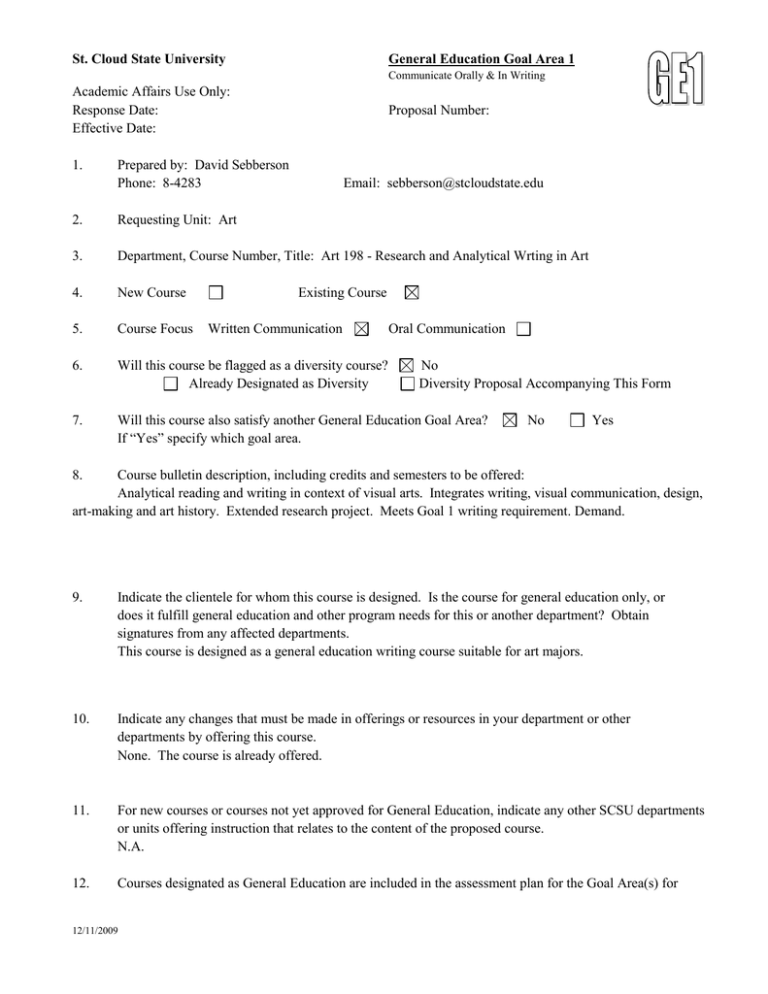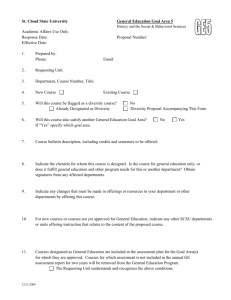GE-10-26. Art 198 - St. Cloud State University
advertisement

St. Cloud State University General Education Goal Area 1 Communicate Orally & In Writing Academic Affairs Use Only: Response Date: Effective Date: 1. Proposal Number: Prepared by: David Sebberson Phone: 8-4283 Email: sebberson@stcloudstate.edu 2. Requesting Unit: Art 3. Department, Course Number, Title: Art 198 - Research and Analytical Wrting in Art 4. New Course 5. Course Focus 6. Will this course be flagged as a diversity course? Already Designated as Diversity 7. Will this course also satisfy another General Education Goal Area? If “Yes” specify which goal area. Existing Course Written Communication Oral Communication No Diversity Proposal Accompanying This Form No Yes 8. Course bulletin description, including credits and semesters to be offered: Analytical reading and writing in context of visual arts. Integrates writing, visual communication, design, art-making and art history. Extended research project. Meets Goal 1 writing requirement. Demand. 9. Indicate the clientele for whom this course is designed. Is the course for general education only, or does it fulfill general education and other program needs for this or another department? Obtain signatures from any affected departments. This course is designed as a general education writing course suitable for art majors. 10. Indicate any changes that must be made in offerings or resources in your department or other departments by offering this course. None. The course is already offered. 11. For new courses or courses not yet approved for General Education, indicate any other SCSU departments or units offering instruction that relates to the content of the proposed course. N.A. 12. Courses designated as General Education are included in the assessment plan for the Goal Area(s) for 12/11/2009 which they are approved. Courses for which assessment is not included in the annual GE assessment report for two years will be removed from the General Education Program. The Requesting Unit understands and recognizes the above conditions. 12/11/2009 13. Provide a concise explanation of how the following goal is a “significant focus” of the proposed course. Goal Area 1: Communicate Orally & in Writing Develop, convey, and evaluate oral and written communication in various academic, professional and personal contexts. Use oral and written communication characterized by clarity, critical analysis, logic, coherence, precision, and rhetorical awareness. Use writing and speaking processes (such as inventing, organizing, drafting, revising, editing, and presenting) as appropriate for specific tasks and audiences. Art 198 is a first-year writing course contextualized by art. The predominant purpose of the course is to teach students strategies, skills, and processes to think in words – clearly, critically, coherently, precisely – and to write with rhetorical effectiveness. A related purpose of the course is to teach students to conduct both primary and secondary research, analyze different perspectives and materials, and integrate them in coherently developed discourse. 14. In order for a course to be designated as fulfilling Goal Area 1, it must address at least 6 of the 8 student learning outcomes (SLOs) below. Check the SLOs below that are focused on in the proposed general education course. 1. Use writing and speaking processes (such as inventing, organizing, drafting, revising, editing, and presenting) as appropriate for specific tasks and audiences. 2. Listen, think critically and creatively, reflect, and respond appropriately to group tasks, relationships, and processes. 3. Locate, evaluate, and synthesize material from diverse sources (print and non-print) and multiple points of view, using them in a responsible and ethical manner. 4. Evaluate communicative situations and use rhetorical tools appropriate for those situations. 5. Construct logical and coherent arguments, recognizing the role and value of credibility (ethos), point of view, emotional appeals (pathos), and individual voice and style in writing and in speaking. 6. Employ syntax, usage, and style appropriate to academic disciplines, for professional environments, and for personal expression and interpersonal exchange. 7. Describe, summarize, and analyze written and spoken discourse, noting how language affects and reflects our perception of human values, cultural perspectives, and gender identities. 8. Identify and use appropriate skills for diverse types and levels of listening and/or reading. 15. Discuss how each Student Learning Outcome checked above is achieved in this course. (Note: Although descriptions of typical assignments or types of assignments may be part of this discussion, it is not appropriate to submit copies of actual assignments.) 1. To prepare writing assignments, students routinely engage in inventing, organizing, drafting, revising, editing, and presenting. 3. In conducting analysis and research for writing assignments students must locate, evaluate, and synthesize material from diverse sources and points of view. The ethics of art in general is centered on paying attention to the contexts of works of art. Throughout the art curriculum, including Art 198, students are taught to move from 12/11/2009 very limited, personal tastes of like/don’t like/that’s not art to analyses of cultural, historical, social, and political contexts that shape the making and meaning of art and design. 4. In analyzing art and writing about art, students learn to evaluate the rhetorical effectiveness of what’s being communicated visually and verbally. In course readings, students analyze not only content but how the writing is constructed. In peer review sessions, students evaluate the effectiveness of their peers’ writing and make recommendations for improved effectiveness. 5. Throughout their writing assignments, students focus on coherence as a basic tenet of writing, whether it tends toward the more formal or logical structures of analysis and researched argument or toward the more variable structures of an artist’s statement. Students learn to modulate the tones of their voices, along with their ethos and pathos, as they learn to develop and articulate their variable roles as artists, critics, and academics. 6. Throughout their writing assignments, students engage in a variety of activities – e.g. exercises, presentations, tutoring, peer review – in which they develop their syntactic, usage, and stylistic skills and apply them appropriately. 7. Throughout their writing assignments, students engage in description, a key element in writing about art regardless of the rhetorical situation. Parts of the course focused on research require that student summarize and analyze both primary sources (images, actual art and design projects) and secondary sources (writing about art and design). By looking at art, and reading about art, and writing about art, students learn how human values, cultural perspectives, and gendered identities are constructed in and reflected by the discourses that surround art, including their own. 16. List or attach the Course Outline (adequately described and including percentage of time to be allocated to each topic). Curriculum Committees may request additional information. Topics larger than 20% need to be broken down further. Indicate in your course outline where the Student Learning Outcomes checked above are being met. Writing Processs and Integration (40%) Integrating visual and verbal information (10%). Learning Outcomes 1, 3, 4, 5, 6 Writing as a design process (15%). Learning Outcomes 1, 3, 4, 5, 6 Modulating voice and style (5%). Learning Outcomes 1, 6 Evaluating, revising, and editing own writing (5%). Learning Outcomes 1, 4, 6 Evaluating visual and verbal information (5%). Learning Outcome 7 Thinking in Words (60%) Developing critical/analytical perspectives through writing (20%). Learning Outcomes 1, 3, 4, 5, 6, 7 Using writing to analyze and interpret researched material (20%). Learning Outcomes 1, 3, 4, 5, 6,7 Practicing modes of inquiry and development (10%). Learning Outcomes 1, 5, 7 Planning and undertaking research (10%). Learning Outcomes 3, 5, 7 12/11/2009 St. Cloud State University General Education Transmittal Form Academic Affairs Use Only: Response Date: Effective Date: Proposal Number Department: Art Course or Course(s): Art 198 - Research and Analytical Wrting in Art David Sebberson Department or Unit Chair Signature January 9, 2010 Date Department forward to Academic Affairs for publication and electronically to Chair of General Education Committee, Chair of College Curriculum Committee, College Dean Recommendation of General Education Committee: Approve Remarks: Disapprove Chairperson Committee Signature Date Recommendation of University Curriculum Committee: Approve Remarks: Disapprove Chairperson Committee Signature Date Recommendation of Faculty Association: Approve Remarks: Disapprove FA Senate Signature Date Action of Academic Vice President: Approve Disapprove Signature Entered in Curriculum Data File 12/11/2009 Remarks: Date




